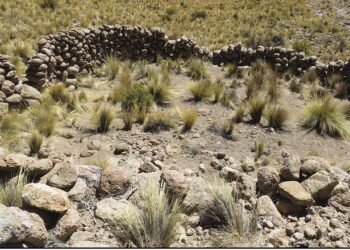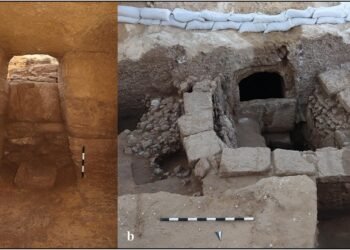An international team, led by researchers from Freie Universität Berlin, has unearthed fortified prehistoric settlements in the remote Siberian region.

Published in the journal Antiquity, the study titled “The World’s Oldest-Known Promontory Fort: Amnya and the Acceleration of Hunter-Gatherer Diversity in Siberia 8000 Years Ago” details the discovery of the world’s oldest-known fortress.
The fortified settlement of Amnya, situated in Siberia’s Lower Ob’ region, stands as the northernmost Stone Age fort in Eurasia. Researchers, including Professor Henny Piezonka and Dr. Natalia Chairkina from Freie Universität Berlin, conducted extensive fieldwork in 2019, revealing ten house pits encircled by earthen walls and wooden palisades, suggesting advanced architectural and defensive capabilities.
This discovery, approximately 8,000 years old according to radiocarbon dating, challenges the established notion that such structures emerged only after the adoption of agriculture.

Tanja Schreiber, an archaeologist from the Institute of Prehistoric Archaeology in Berlin and a co-author of the study said: “Through detailed archaeological examinations at Amnya, we collected samples for radiocarbon dating, confirming the prehistoric age of the site and establishing it as the world’s oldest-known fort.”
The prehistoric inhabitants of Amnya, living in Siberia’s taiga environment, led a sophisticated lifestyle centered around abundant resources. Fish from the Amnya River, elk, and reindeer were hunted using bone and stone-tipped spears, and surplus fish oil and meat were preserved in elaborately decorated pottery. This challenges previous assumptions about the capabilities and complexity of hunter-gatherer societies.
The research team’s findings hint at the competitive nature of these ancient communities. The abundance of natural resources in the Siberian taiga, including annual fish runs and migrating herds, likely influenced the construction of fortified settlements. These strategic locations overlooking rivers may have served as a means to control and exploit productive fishing spots, revealing a competitive aspect previously thought absent in hunter-gatherer societies.
The study challenges the traditional narrative associating the rise of societal complexity with the advent of agriculture.
While the purpose of these fortifications remains speculative, theories range from protection during violent conflicts to territorial marking, and even safe storage of high-calorie resources like fish oil. The fortresses may have also emerged as a response to increased inter-group conflict as immigrants migrated into northern Siberia.
The research, spanning various disciplines and involving German and Russian researchers, suggests that the need for such fortifications challenges the idea that competition and violence were absent in the pre-agricultural world.





















